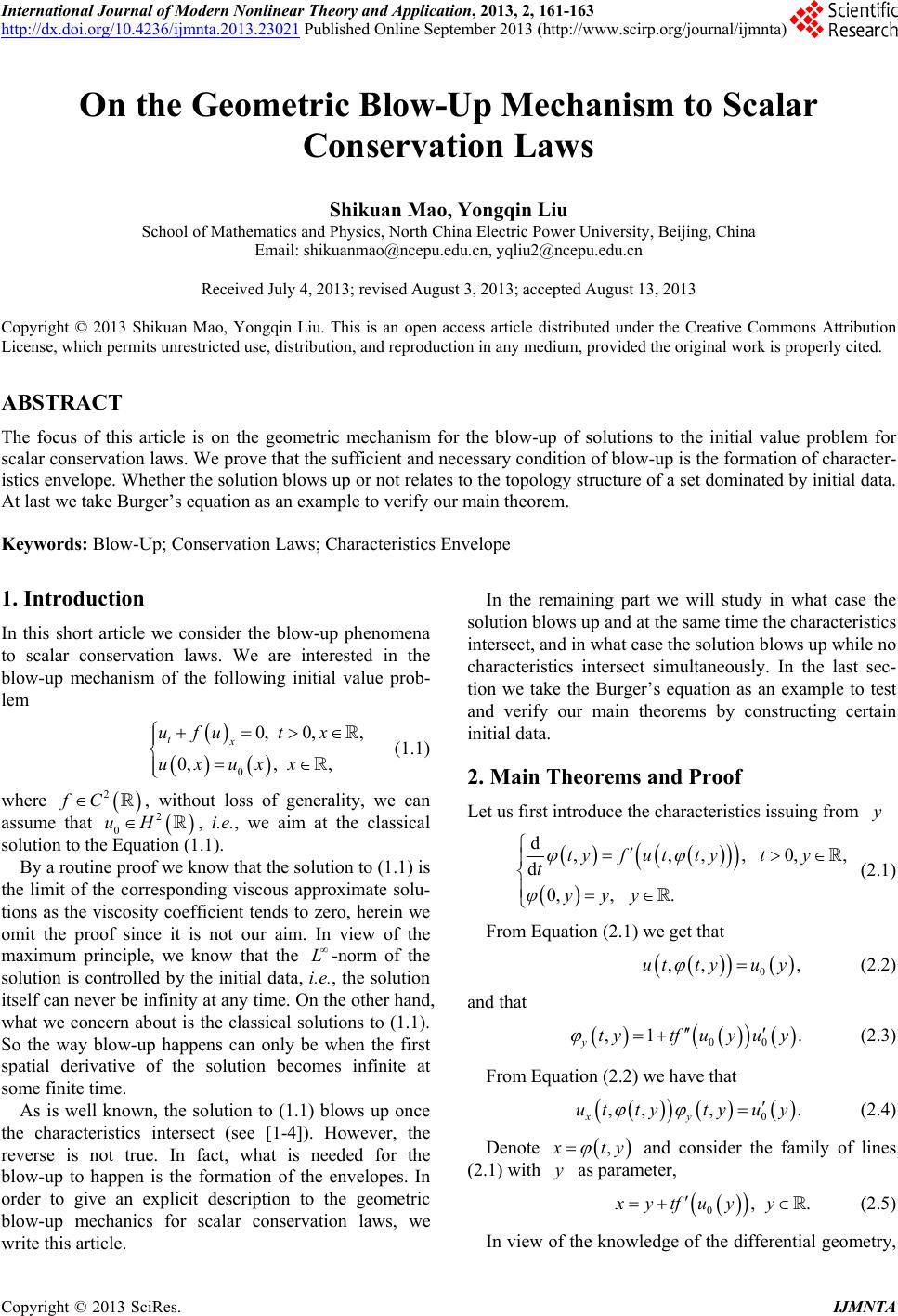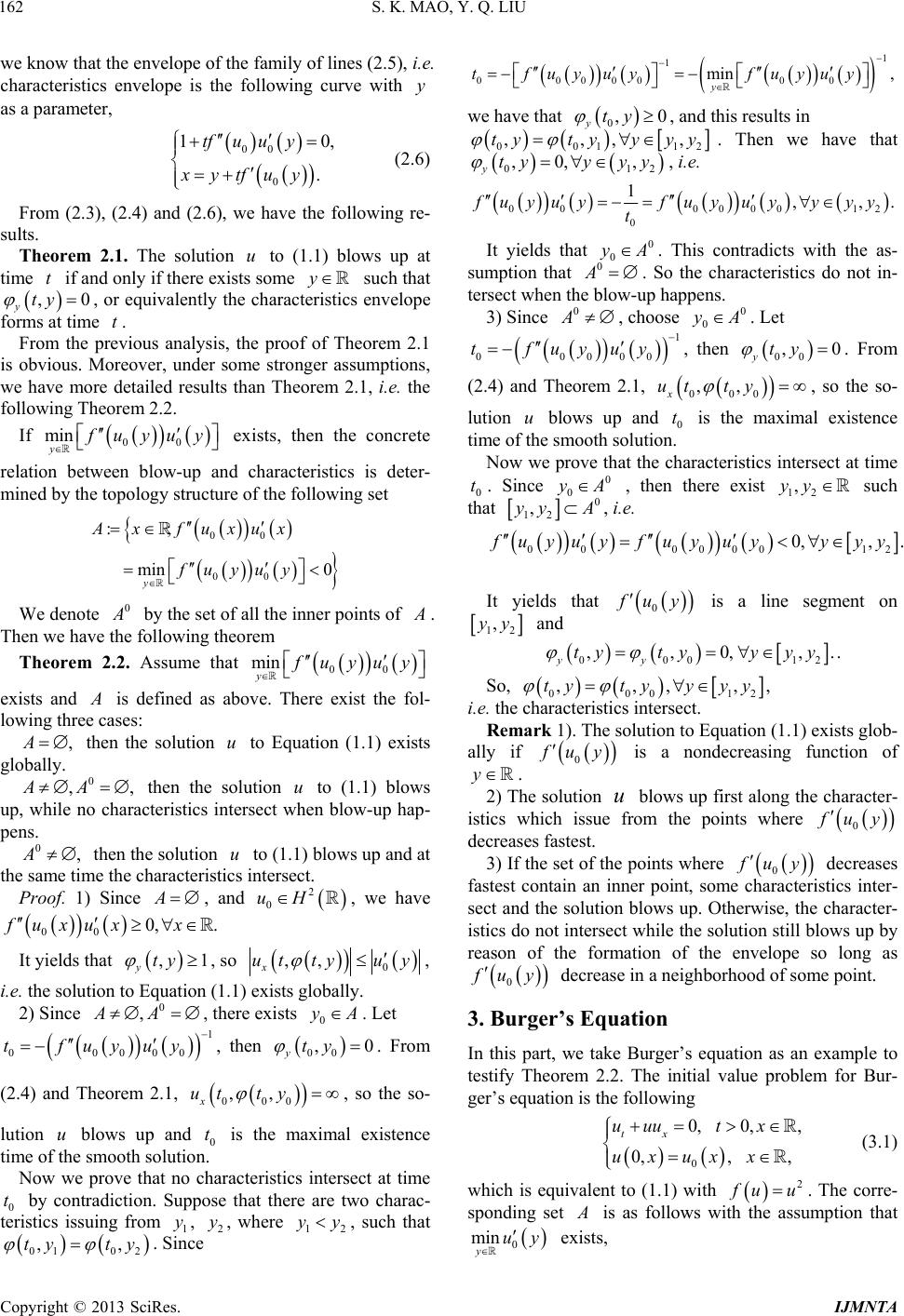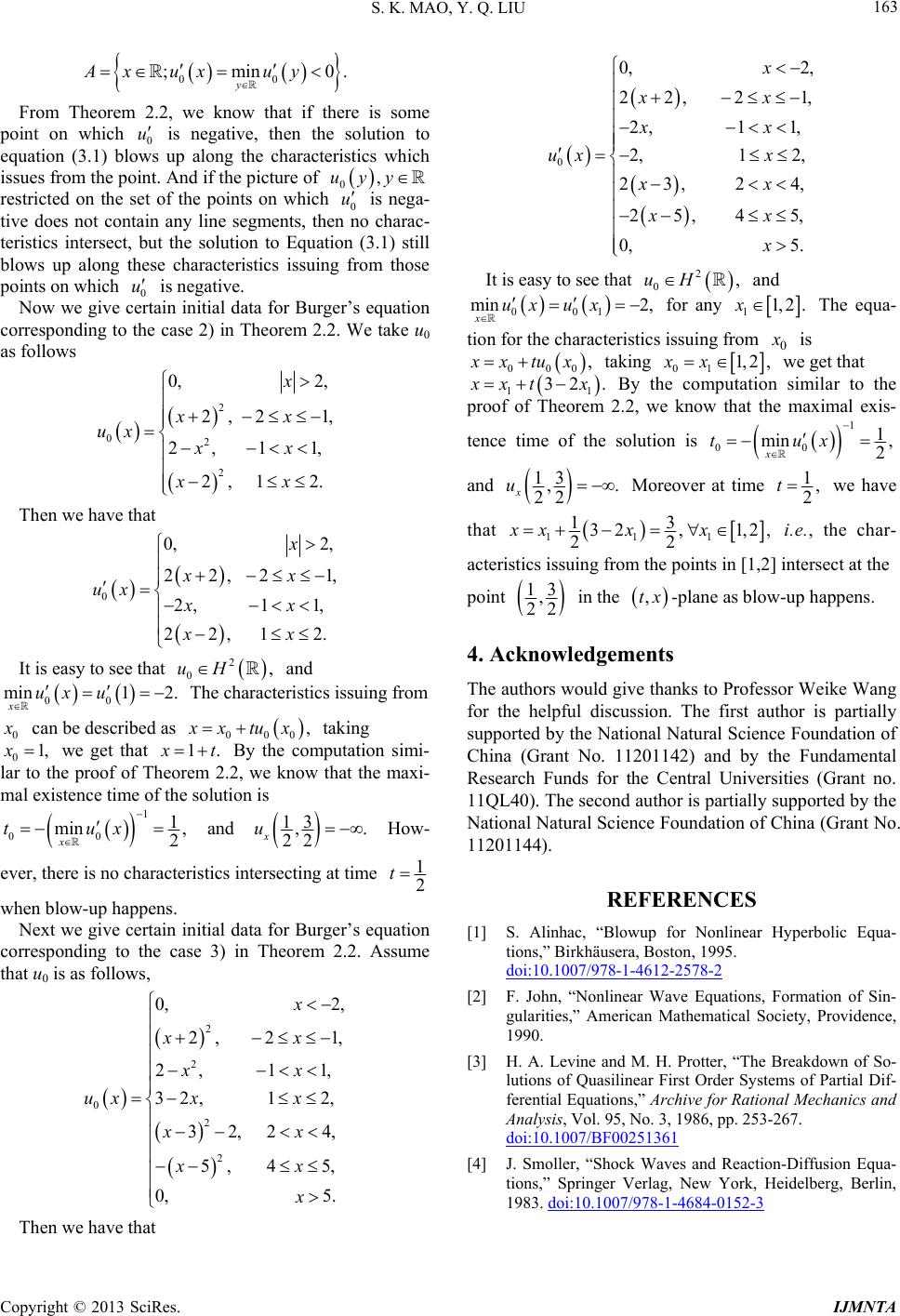 International Journal of Modern Nonlinear Theory and Application, 2013, 2, 161-163 http://dx.doi.org/10.4236/ijmnta.2013.23021 Published Online September 2013 (http://www.scirp.org/journal/ijmnta) On the Geometric Blow-Up Mechanism to Scalar Conservation Laws Shikuan Mao, Yongqin Liu School of Mathematics and Physics, North China Ele ct ric Power Uni versity, Beijing, China Email: shikuanmao@ncepu.edu.cn, yqliu2@ncepu.edu.cn Received July 4, 2013; revised August 3, 2013; accepted August 13, 2013 Copyright © 2013 Shikuan Mao, Yongqin Liu. This is an open access article distributed under the Creative Commons Attribution License, which permits unrestricted use, distribution, and reproduction in any medium, provided the original work is properly cited. ABSTRACT The focus of this article is on the geometric mechanism for the blow-up of solutions to the initial value problem for scalar conservation laws. We prove that the sufficient and necessary condition of blow-up is the formation of character- istics envelope. Whether the solution blows up or not relates to the topology stru cture of a set dominated by in itial data. At last we take Burger’s equation as an example to verify our main theorem. Keywords: Blow-Up; Conservation Laws; Characteristics Envelope 1. Introduction In this short article we consider the blow-up phenomena to scalar conservation laws. We are interested in the blow-up mechanism of the following initial value prob- lem 0 0, 0,, 0,, , tx ufut x uxuxx (1.1) where , without loss of generality, we can assume that , i.e., we aim at the classical solution to the Equa tion (1.1). 2 fC 0 uH 2 By a routine proof we know that the so lu tion to (1.1 ) is the limit of the corresponding viscous approximate solu- tions as the viscosity coefficient tends to zero, herein we omit the proof since it is not our aim. In view of the maximum principle, we know that the -norm of the solution is controlled by the initial data, i.e., the solution itself can never be infinity at any time. On the other hand, what we concern about is the classical solutions to (1.1). So the way blow-up happens can only be when the first spatial derivative of the solution becomes infinite at some finite time. L As is well known, the solution to (1.1) blows up once the characteristics intersect (see [1-4]). However, the reverse is not true. In fact, what is needed for the blow-up to happen is the formation of the envelopes. In order to give an explicit description to the geometric blow-up mechanics for scalar conservation laws, we write this article. In the remaining part we will study in what case the solution blows up and at th e sa me time the ch aracteristics intersect, and in what case the solution blows up while no characteristics intersect simultaneously. In the last sec- tion we take the Burger’s equation as an example to test and verify our main theorems by constructing certain initial data. 2. Main Theorems and Proof Let us first introduce the characteristics issuing from y d,,,,0, d 0, ,. tyf uttyty t yyy , (2.1) From Equation (2.1) we get that 0 ,,uttyuy , (2.2) and that 00 ,1 ytytf u yu y . (2.3) From Equation (2.2) we have that 0 ,, , xy u ttytyuy . (2.4) Denote , ty y and consider the family of lines (2.1) with as parameter, 0,xytfuy y . (2.5) In view of the knowledge of the differential geometry, C opyright © 2013 SciRes. IJMNTA  S. K. MAO, Y. Q. LIU 162 we know that the envelope of the family of lines (2.5), i.e. characteristics envelope is the following curve with as a parameter, y 0 0 0 10 . tfu uy xytfuy , 0 (2.6) From (2.3), (2.4) and (2.6), we have the following re- sults. Theorem 2.1. The solution to (1.1) blows up at time if and only if there exists some such that y, or equivalently the characteristics envelope forms at time . u t ,ty y t From the previous analysis, the proof of Theorem 2.1 is obvious. Moreover, under some stronger assumptions, we have more detailed results than Theorem 2.1, i.e. the following Theorem 2.2. If 00 min y uyuy exists, then the concrete relation between blow-up and characteristics is deter- mined by the topology structure of the following set 00 00 :; min 0 y Ax fuxux fuyuy We denote 0 by the set of all the inner points of . Then we have the following t h eorem Theorem 2.2. Assume that 00 min y uyuy exists and is defined as above. There exist the fol- lowing three cases: ,A then the solution to Equation (1.1) exists globally. u 0 ,AA , 1 then the solution to (1.1) blows up, while no characteristics intersect when blow-up hap- pens. u 0,A then the solution u to (1.1 ) blo w s up and at the same time the characteristics intersect. Proof. 1) Since , and , we have A 0, x 2 0 uH 00 fuxux . It yields that , so , yty 0 ,, x ut tyuy , i.e. the solution to Equation (1.1) exists globally. 2) Since , there exists . Let 0 ,AA 0 yA 0 1 0000 tfuy uy , then . From (2.4) and Theorem 2.1, 00 , yty 0 00 0 ,,ty x ut , so the so- lution blows up and 0 t is the maximal existence time of the smooth solution. u Now we prove that no characteristics intersect at time 0 by contradiction. Suppose that there are two charac- teristics issuing from 1, , where , such that . Since ty 2 y1 yy 1 1 00000 00 min , y tfuy uyfuyuy we have that 0, yty 0, and this results in 001 ,,,ty y 12 . Then we have that ,ty yy 01 , ,y yy 2 ,0 yty , i.e. 000000 0 1,, 12 . uyuyfuy uyyyy t It yields that 0 0 A 0 A. This contradicts with the as- sumption that . So the characteristics do not in- tersect when the blow-up happens. 3) Since 0 A , choose 0 0 A. Let 0 1 0000 tfuy uy , then 00 , yty 0 . From (2.4) and Theorem 2.1, 00 0 ,,ty x ut , so the so- lution blows up and 0 is the maximal existence time of the smooth solution. ut Now we prov e that the characteristics intersect at time 0. Since t0 0 A , then there exist 12 ,yy such that 0 12 A,yy , i.e. 000000 0,, . 21 uyuyfuy uyyyy It yields that 0 uy is a line segment on 12 , y and 000 1 ,,0,, yy tytyy yy 2 .. So, 0001 ,,,,tytyy yy 2 , i.e. the characteristics intersect. Remark 1). The solution to Equation (1.1) exists glob- ally if 0 uy is a nondecreasing function of y . 2) The solution blows up first along the character- istics which issue from the points where u 0 uy decreases fastest. 3) If the set of the points where 0 uy decreases fastest contain an inner point, some characteristics inter- sect and the solution blows up. Otherwise, the character- istics do not intersect while the solution still blows up by reason of the formation of the envelope so long as 0 uy decrease in a neighborhood of some point. 3. Burger’s Equation In this part, we take Burger’s equation as an example to testify Theorem 2.2. The initial value problem for Bur- ger’s equation is the following 0 0, 0,, 0,, , tx uuut x uxuxx (3.1) which is equivalent to (1.1) with 2 uu. The corre- sponding set is as follows with the assumption that 0 min yuy exists, 2 , 01 02 ,ty ty Copyright © 2013 SciRes. IJMNTA  S. K. MAO, Y. Q. LIU Copyright © 2013 SciRes. IJMNTA 163 0. 00 ;min y Ax uxuy From Theorem 2.2, we know that if there is some point on which 0 is negative, then the solution to equation (3.1) blows up along the characteristics which issues from the point. And if the picture of u 0,uyy u restricted on the set of the points on which 0 is nega- tive does not contain any line segments, then no charac- teristics intersect, but the solution to Equation (3.1) still blows up along these characteristics issuing from those points on whi ch is negative. 0 Now we give certain initial data for Burger’s equation corresponding to the case 2) in Theorem 2.2. We take u0 as follows u 2 02 2 0, 2, 2, 21, 2, 11, 2, 12. x xx ux xx xx Then we have that 0 0, 2, 22,2 2,1 1, 22,1 2. x xx ux xx xx 1, It is easy to see that and 2 0,uH 2. 00 min 1 xux u The characteristics issuing from 0 can be described as 000 , xtux 1. taking 0 we get that 1,x t By the computation simi- lar to the proof of Theorem 2.2, we know that the maxi- mal existence time of the so lution is 1 00 1 min , 2 x tux and 3 1, 22 x u. How- ever, there is no characteristics intersecting at time 1 2 t when blow-up happens. Next we give certain initial data for Burger’s equation corresponding to the case 3) in Theorem 2.2. Assume that u0 is as follows, 2 2 0 2 2 0, 2, 2, 21, 2,11, 32,1 2, 32,2 4, 5, 45, 0, 5. x xx xx ux xx xx xx x , 0 0, 2, 22,21 2,1 1, 2,1 2, 23,2 4, 25, 45, 0, 5. x xx xx ux x xx xx x It is easy to see that and 2 0,uH 001 min xuxux Then we have that 2, for any 11, 2.x The equa- tion for the characteristics issuing from 0 is 000 , xtux taking 01 1, 2xx , we get that 32 11 . xt x By the computation similar to the proof of Theorem 2.2, we know that the maximal exis- tence time of the solution is 1 00 1 min , 2 x tux and 3 1, 22 x u. Moreover at time 1, 2 t we have that 111 3 132,1,2, 22 xxxx i.e., the char- acteristics issuing from the points in [1,2] intersect at the point 3 1, 22 in the ,tx-plane as blow-up happens. 4. Acknowledgements The authors would give thanks to Professor Weike Wang for the helpful discussion. The first author is partially supported by the National Natural Science Found ation of China (Grant No. 11201142) and by the Fundamental Research Funds for the Central Universities (Grant no. 11QL40). The second autho r is partially supported by the National Natural Science Foundation of China (Gran t No. 11201144). REFERENCES [1] S. Alinhac, “Blowup for Nonlinear Hyperbolic Equa- tions,” Birkhäusera, Boston, 1995. doi:10.1007/978-1-4612-2578-2 [2] F. John, “Nonlinear Wave Equations, Formation of Sin- gularities,” American Mathematical Society, Providence, 1990. [3] H. A. Levine and M. H. Protter, “The Breakdown of So- lutions of Quasilinear First Order Systems of Partial Dif- ferential Equations,” Archive for Rational Mechanics and Analysis, Vol. 95, No. 3, 1986, pp. 253-267. doi:10.1007/BF00251361 [4] J. Smoller, “Shock Waves and Reaction-Diffusion Equa- tions,” Springer Verlag, New York, Heidelberg, Berlin, 1983. doi:10.1007/978-1-4684-0152-3
|